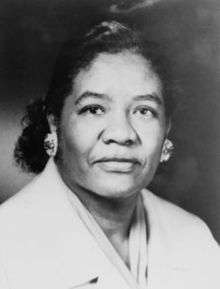Dorothy Lavinia Brown
| Dorothy Lavinia Brown | |
|---|---|
 | |
| Born |
January 7, 1919 Philadelphia, Pennsylvania |
| Died |
June 13, 2004 Nashville, Tennessee |
| Occupation |
|
| Known for | first African American in the Tennessee General Assembly |
Dr. Dorothy Lavinia Brown[1] (January 7, 1919 – June 13, 2004[2]), also known as "Dr. D.",[3] was an African-American surgeon, legislator, and teacher. She was the first female surgeon of African-American ancestry from the Southeastern United States. She was also the first African American to serve in the Tennessee General Assembly having been elected to the Tennessee House of Representatives.[3][4]
Biography
Brown was born in Philadelphia, Pennsylvania,[5] and was placed in an orphanage in Troy, New York at five months old by her mother, Edna Brown, where she lived to the age of 12. While at the orphanage, she underwent a tonsillectomy operation, an experience that led to her interest in the field of medicine.[3] Although her mother tried to persuade the young Dorothy to live with her, Brown kept running away from home, only to return to the Troy orphanage. Upon reaching the age of fifteen, Brown ran away to enroll at the Troy High School. She worked as a mother's helper in the house of Mrs. W. F. Jarrett,[5] in Albany, New York.[6] Assisted by a principal of the school, she was introduced to Samuel Wesley and Lola Redmon, a couple who became her foster parents.[3]
Education
After finishing high school, while working as a domestic helper, Brown attended Bennett College in Greensboro, North Carolina, receiving assistance from the Women's Division of Christian Service of a Methodist Church in Troy in order to gain a scholarship.[5] Following college, she worked at the Rochester Army Ordnance Department in Rochester, New York for two years.[3] In 1941, she obtained her Bachelor of Arts degree,[5] and became an inspector for a defense plant in Troy.[5] In 1944, Brown began studying medicine at Meharry Medical College in Nashville, finishing her internship at the Harlem Hospital in New York City.[3] After graduating in 1948,[5] she became a resident at Hubbard Hospital of Meharry in 1949, despite opposition to female surgeons and having convinced the then chief surgeon, Matthew Walker, Sr., M.D.,[3][5] Brown completed her residency in 1954.[5]
Career
Brown was the chief surgeon at the now-defunct Riverside Hospital in Nashville from 1957 to 1983.[3] In 1966, she became the first African-American female to be elected to the Tennessee General Assembly (known also as the Tennessee State Legislature[5]), a position she held for two years.[5] She almost succeeded in having abortions legalized in cases of rape or incest, and in expanding the already existing legally permitted abortions in cases when the "mother’s life was in danger".[3] During her career as a politician, Brown also became involved in the passing of the Negro History Act, which required public schools in Tennessee to "conduct special programs during Negro History Week to recognize accomplishments made by African Americans".[3]
In 1968, Brown tried to obtain a seat in the Tennessee Senate, but lost in part due to her support for abortion laws.[5] In 1968, following her departure from politics, Brown returned to becoming a full-time physician at the Riverside Hospital.[3] Brown also acted as an attending surgeon at the George W. Hubbard and General Hospitals, as director of education for the clinical rotation program of the Riverside and Meharry Hospitals.[3] She was also a surgery professor at the Meharry Medical College and consulted for the National Institutes of Health in the Heart, Lung, and Blood advisory council.[5][7]
Personal life
In 1956, Brown agreed to adopt a female child from an unmarried patient at the Riverside Hospital. Brown became the first known single female in Tennessee to legally adopt a child, whom she named Lola Denise Brown in honor of her foster mother.[3] Brown was a member of the United Methodist Church.[5]
Writing
Brown wrote an autobiography,[3] essays, and inspirational guides.[5]
Recognitions
In 1959, she became the third woman to become a Fellow of the American College of Surgeons, the first African-American woman to be elected.[3][7] In 1971, the Dorothy L. Brown Women's Residence at Meharry Medical College, Nashville, was named after her. She also received honorary doctorate degrees from the Russell Sage College in Troy, New York, and also from Bennett College in Greensboro, North Carolina.[3] In particular, she received her honorary degrees in the Humanities from Bennett College and Cumberland University.[5]
Brown was a member of the board of trustees at Bennett College and of the Delta Sigma Theta sorority. She participated as a speaker on panels that discussed scientific, religious, medical, and political issues.[5] Brown was also awarded the Horatio Alger Award in 1994 and the Carnegie Foundation's humanitarian award in 1993.[7]
Death
She died in Nashville, Tennessee, in 2004 from congestive heart failure.[8]
References
- ↑ Brown, Lola Denise (daughter of Dorothy Lavinia Brown). "Dorothy L. Brown". African American Registry. Archived from the original on June 29, 2009.
- ↑ Martini, Kelli. Dorothy Brown, South’s first African-American woman doctor, dies, News Archives, The United Methodist Church, June 14, 2004, UMC.org
- 1 2 3 4 5 6 7 8 9 10 11 12 13 14 15 16 Anne-Leslie Owens, "Dorothy Lavinia Brown," Tennessee Encyclopedia of History and Culture, 2002.
- ↑ Windsor, Laura Lynn (2002). Women in Medicine: An Encyclopedia. ABC-CLIO. pp. 37–38. ISBN 978-1-57607-392-6.
- 1 2 3 4 5 6 7 8 9 10 11 12 13 14 15 16 McKenzie, Julie and Denita Denhart. Dorothy Lavinia Brown, The Scientist Bank, cspumona.edu
- ↑ Warren, WiniBlack Women Scientists in the United States, pp 19–23
- 1 2 3 "Changing the Face of Medicine | Dr. Dorothy Lavinia Brown". www.nlm.nih.gov. Retrieved 2016-02-26.
- ↑ "Surgical Pioneer, Dorothy Lavinia Brown". African American Registry. Retrieved February 22, 2014.